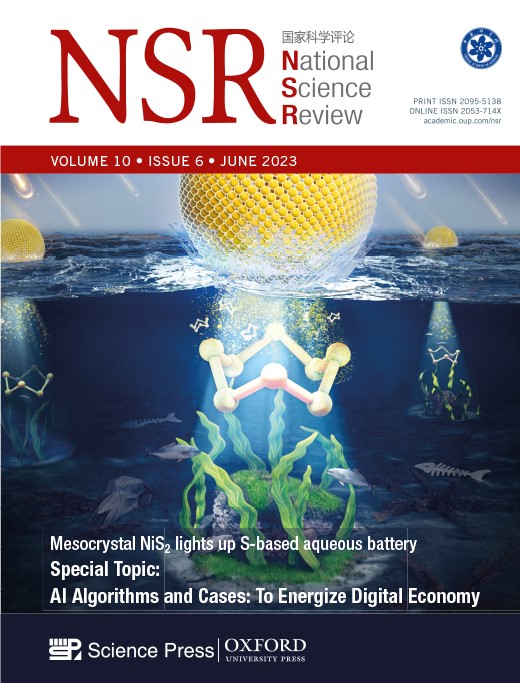用功能化石墨二炔对铜纳米线表面进行电子扰动以增强二氧化碳还原反应
IF 16.3
1区 综合性期刊
Q1 MULTIDISCIPLINARY SCIENCES
引用次数: 0
摘要
铜催化剂表面的电子扰动对于优化电化学二氧化碳还原活性至关重要,但仍面临巨大挑战。在本文中,通过表面包覆电子吸收(-F)和电子捐献(-Me)基团官能化的石墨化二炔(R-GDY,R = -F和-Me),实现了具有微调表面电子结构的纳米结构铜纳米线(NW),由此制备的催化剂(称为R-GDY/Cu NW)显示出独特的二氧化碳还原性能。原位电化学光谱显示,*CO(二氧化碳还原反应的一个关键中间产物)的结合亲和力以及由此产生的*CO覆盖率与铜表面氧化态呈正相关,从而导致 F-GDY/Cu NW 上的 C-C 耦合性能优于 Me-GDY/Cu NW。电化学测量证实了 F-GDY/Cu NW 有利于产生 C2H4,其最佳 C2+ 选择性为 73.15% ± 2.5%,而 Me-GDY/Cu NW 则主要有利于产生 CH4。此外,利用*Cu-OH/*CO 比率作为描述因子,机理研究表明,*Cu-OH 促进的独特吸附*CO 的质子化对于 F-GDY/Cu NW 和 Me-GDY/Cu NW 上分别选择性生成 C2H4 和 CH4 至关重要。本文章由计算机程序翻译,如有差异,请以英文原文为准。
Electronic perturbation of Cu nanowire surfaces with functionalized graphdiyne for enhanced CO2 reduction reaction
Electronic perturbation of Cu catalysts surface is crucial for optimizing electrochemical CO2 reduction activity, yet still poses great challenges. Herein, nanostructured Cu nanowires (NW) with fine-tuned surface electronic structure are achieved via surface encapsulation with electron-withdrawing (–F) and -donating (–Me) group-functionalized graphdiynes (R-GDY, R = –F and –Me), and the resulting catalysts, denoted as R-GDY/Cu NW, display distinct CO2 reduction performances. In-situ electrochemical spectroscopy revealed that the *CO (a key intermediate of the CO2 reduction reaction) binding affinity and consequent *CO coverage positively correlate to the Cu surface oxidation state, leading to the favorable C–C coupling on F-GDY/Cu NW over Me-GDY/Cu NW. Electrochemical measurements corroborate the favorable C2H4 production with an optimum C2+ selectivity of 73.15% ± 2.5% observed for F-GDY/Cu NW, while the predominant CH4 production is favored by Me-GDY/Cu NW. Furthermore, leveraging the *Cu–OH/*CO ratio as a descriptor, mechanistic investigation reveals that the protonation of distinct adsorbed *CO facilitated by *Cu–OH is crucial for the selective generation of C2H4 and CH4 on F-GDY/Cu NW and Me-GDY/Cu NW, respectively.
求助全文
通过发布文献求助,成功后即可免费获取论文全文。
去求助
来源期刊

National Science Review
MULTIDISCIPLINARY SCIENCES-
CiteScore
24.10
自引率
1.90%
发文量
249
审稿时长
13 weeks
期刊介绍:
National Science Review (NSR; ISSN abbreviation: Natl. Sci. Rev.) is an English-language peer-reviewed multidisciplinary open-access scientific journal published by Oxford University Press under the auspices of the Chinese Academy of Sciences.According to Journal Citation Reports, its 2021 impact factor was 23.178.
National Science Review publishes both review articles and perspectives as well as original research in the form of brief communications and research articles.
 求助内容:
求助内容: 应助结果提醒方式:
应助结果提醒方式:


